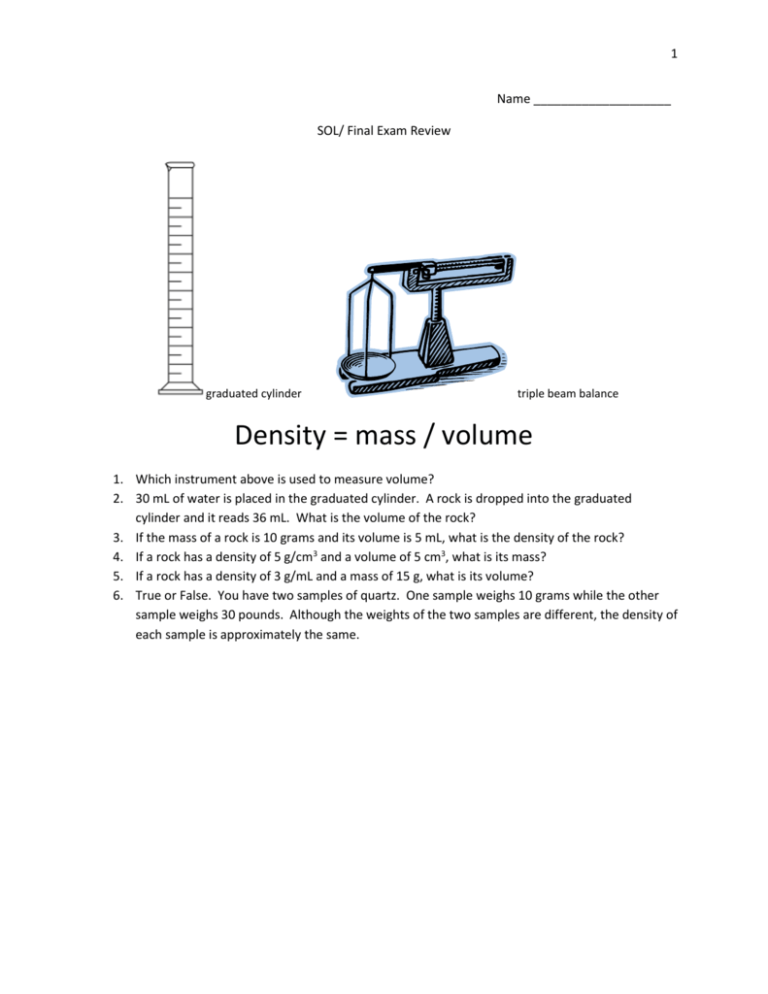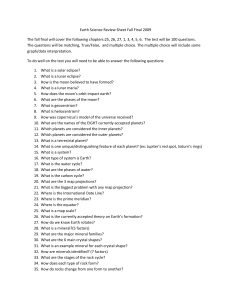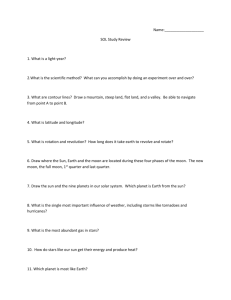Review Diagrams
advertisement

1 Name ____________________ SOL/ Final Exam Review graduated cylinder triple beam balance Density = mass / volume 1. Which instrument above is used to measure volume? 2. 30 mL of water is placed in the graduated cylinder. A rock is dropped into the graduated cylinder and it reads 36 mL. What is the volume of the rock? 3. If the mass of a rock is 10 grams and its volume is 5 mL, what is the density of the rock? 4. If a rock has a density of 5 g/cm3 and a volume of 5 cm3, what is its mass? 5. If a rock has a density of 3 g/mL and a mass of 15 g, what is its volume? 6. True or False. You have two samples of quartz. One sample weighs 10 grams while the other sample weighs 30 pounds. Although the weights of the two samples are different, the density of each sample is approximately the same. 2 1. Contour lines on a topographic map are lines of constant ________________________. 2. Where contour lines are close together the slope is ____________________. 3. The contour interval of this map is 40 feet. If you were at 1400 feet and going uphill, what would be your elevation at the next contour line? 4. Concentric circles (circles around other circles) indicate that there is a depression or a _____________________. 5. Rivers and streams always flow _____________________. 3 1. 2. 3. 4. Which hill is taller, A or B? Which hill is steeper, A or B? What is the contour interval of this map? What is the approximate elevation in the dip between hills A and B? 4 1. 2. 3. 4. 5. 6. 7. 0o latitude is known as the ______________________________. 0o longitude is known as the ______________________________. What continent are you in if you are at 45oN and 120oW? What continent are you in if you are at 60oN and 90oE? What continent are you in if you are at 30oS and 150oE? What continent are you in if you are at 15oS and 60oW? At (0o,0o) you would be off the west coast of _________________________. 5 1. Name the 4 inner planets in order. 2. Name the 4 outer planets in order. 3. The dwarf planet Pluto is occasionally closer to the Sun than the planet _____________________. 4. Which planet has the shortest orbital period? 5. Which planet has the fastest orbital velocity? 6. Which planet is known as Earth’s twin? 7. Which planet is known as the “Red Planet” and has giant canyons and volcanoes? 8. Which planet is the largest and has a giant hurricane on its surface? 9. Which planet is bigger, Neptune or Earth? 10. Which planet is denser, Saturn or Mercury? 6 1. In which direction do the planets revolve around the Sun (as viewed from the North), CW or CCW? 2. What is another name for the 4 inner planets? 3. Does it take Mars more than a year or less than a year to go around the Sun once? 4. About how many minutes does it take light to travel from the Sun to the Earth? 5. It takes 43 minutes for light to travel from the Sun to the planet ______________________. 6. Which 2 planets shown in this diagram have the biggest gap between them? 7. What is located between the 2 planets mentioned above? 7 1. The 4 outer planets are also known as the __________________ giants. 2. The 4 outer planets are made up of mostly _________________________ and ___________________________, the same 2 gases that make up our Sun. 3. Uranus and Neptune, in addition to the 2 gases mentioned above, also contain the gas _______________________. 4. How long does it take light to reach Neptune from the Sun? 5. An astronomical unit is the distance from the Sun to ________________________, which is about 93 million miles. 6. Which planet is 19.2 astronomical units away from the Sun? 8 1. 2. 3. 4. 5. 6. 7. What fraction of the moon is illuminated by the Sun at any given time? True or False. The Earth rotates in the same direction that the moon revolves around the Earth. True or False. Waxing is when the lit portion of the moon decreases each night. During which 2 lunar phases would you get the highest high tides and the lowest low tides? During which 2 lunar phases would you get neap tides? What lunar phase occurs after the first quarter moon? What lunar phase occurs after the third quarter moon? 1. What type of eclipse is shown above? 2. True or False. The distance between the Sun and Earth always stays the same. 3. The darkest shadow of an eclipse is called the _______________________. 9 1. What type of eclipse is shown above? 2. The lighter portion of the eclipse’s shadow is called the _____________________________. 3. True or False. We’ve only seen one side of the moon from Earth. 1. 2. 3. 4. Tides are mainly caused by the gravitational pull of the __________________. Tides are also affected by the gravitational pull of the _______________. _______________________ tides occur when we have either a full moon or a new moon. How many spring tides occur during one lunar cycle? 1. Which lunar phase is shown above? 10 2. A neap tide occurs when the moon and Sun are pulling on Earth’s waters at a ___________ degree angle. 3. True or False. The highest high tides occur during a neap tide. 1. 2. 3. 4. What term above refers to dark organic matter that forms from decaying plants and animals? What term above refers to big chunks of rock? If you dig deep enough you eventually always run into ____________________________. True or False. Areas with fast rates of weathering generally have thick soils, while areas with slow rates of weathering have thin soils. 11 1. 2. 3. 4. The ______________________ is just beneath the crust. The highest temperatures and pressures are found in the ____________________. True or False. The inner core is a liquid. The core contains the metal _________________, causing the Earth to behave like a giant magnet. 5. True or False. There are two types of crust: oceanic and continental. 1. 2. 3. 4. 5. ___________________ is a cloud found at Earth’s surface. The cotton ball cloud is called a ______________________ cloud. The sheet-like cloud is called a _____________________ cloud. ___________________clouds are high-altitude clouds made of ice crystals. Cumulonimbus clouds are associated with __________________storms. 12 1. The Ring of Fire is found mostly around which plate? 2. The Ring of Fire is an area along which there are many earthquakes and active ________________________. 3. The Andes Mountains formed at the convergent boundary between South America and what other plate? 4. The San Andreas Fault is found along the transform boundary between the Pacific Plate and what other plate? 5. True or False. Hawaii formed along the Ring of Fire. 1. What type of plate boundary is shown above, divergent or convergent? 13 2. What is depicted in this diagram, a mid-ocean ridge or a trench? 1. 2. 3. 4. 5. What type of plate boundary is shown above, divergent or convergent? A ___________________ forms at the subduction zone. _______________________ form on the overriding plate. The ____________________ plate always subducts. The subducting plate turns into ___________________________. 1. 2. 3. 4. 5. What type of mountains form when 2 continents collide? The crust and the upper part of the mantle are called the ____________________________. The plastic part of the mantle that flows slowly is called the _____________________________. True or False. Continental crust is denser than oceanic crust. Tectonic plates move due to the process of seafloor ____________________________. 14 1. 2. 3. 4. Water changes into water vapor. Water vapor changes into water to form a cloud. Rain, sleet, snow, etc. True or False. More vegetation will probably increase the amount of runoff that occurs. 1. Our Sun is currently on the main sequence. What will our Sun become once it enters the next stage of its life cycle? 2. The protostar becomes a main sequence star once nuclear ______________________ begins. 3. Our Sun will most likely end its life as a ___________________ dwarf. 15 1. 2. 3. 4. 5. When a white dwarf cools off it becomes a ______________________ dwarf. All stars begin in a cloud of gas and dust called a ______________________. The path a star will follow in this diagram depends on the star’s _____________________. Low mass stars are red. What color are huge/giant stars? True or False. Stars like our Sun become red giants while huge/giant stars become red supergiants. 6. When the red supergiant of a huge star collapses a ____________________star forms. 7. True or False. Our Sun will become a black hole in the very distant future. 16 Name what step in the rock cycle would occur after each of the processes listed below. 1. 2. 3. 4. 5. 6. 7. 8. Crystallization/ cooling Compaction and cementation Weathering and erosion Melting Heat and pressure True or False. Metamorphic rocks are commonly found along subduction zones. True or False. When a rock melts and then cools off a metamorphic rock is formed. True or False. Sedimentary rocks commonly form in aquatic environments. 17 1. What is the top of the groundwater called? 2. The zone completely filled with water is called the __________________________ zone. 3. The unsaturated zone, or the zone of aeration, is filled with some water and _________________. 4. What happens to the water table during a drought? 5. True or False. The water table is also the top of the surface water. 18 Of the 5 stars labeled in the H-R Diagram, pick the one that best fits the following descriptions. 1. 2. 3. 4. 5. 6. 7. 8. 9. 10. The hottest The brightest A blue star on the main sequence Converting hydrogen into helium in its core (3 possible answers) Very hot but relatively dim due to its small size Relatively cool but very bright due to its large size True or False. Our Sun started out with more mass in its nebula than Vega. True or False. Our Sun will eventually become a red giant and a white dwarf. True or False. The red stars are the hottest. True or False. Blue stars are more massive and burn hotter than red stars. 1. 2. 3. 4. 5. What mineral is the softest? What mineral is the hardest? True or False. Flourite can scratch quartz and calcite. What mineral can scratch gypsum and be scratched by fluorite? True or False. Topaz can scratch apatite and be scratched by corundum. 19 1. 2. 3. 4. Which physiographic province do we live in? (give the name or the color) In which province would you find most of Virginia’s coal? (give the name or the color) In which province would you find swamps and marshes? (give the name or the color) Between which 2 provinces would you find the Fall Line, where many waterfalls occur? (give the names or the colors) 5. In which color would you find the Blue Ridge Mountains? 6. Which province has karst topography, including caves and sinkholes? (give the name or the color) 7. True or False. The age of the rock generally increases as you move east to west across Virginia. 20 1. 2. 3. 4. 5. 6. 7. 8. Which rock layer is the youngest in the diagram above? Which rock layer is the oldest? Which happened first, the deposition of L or fault H? Which happened first, A or N? What type of rock is intrusion A? Other than rock A, the other types of rock are most likely what kind? What type of rock could be found where A touches the rock layers around it? What occurred between C and M? 1. 2. 3. 4. What does the H mean? On this map, what type of air would be found in Virginia, warm or cold? What type of air would be found in Illinois, warm or cold? What type of air mass would most likely be over Virginia in this map, maritime tropical (mT) or continental polar (cP)? What type of air mass would most likely be over Illinois, maritime tropical (mT) or continental polar (cP)? Is precipitation usually associated with low pressure (L) or high pressure (H)? Wind always blows from __________________ pressure to __________________ pressure. When the isobars are close together, what does that indicate about wind speed? 5. 6. 7. 8. 21 1. 2. 3. 4. What causes a cone of depression to form? Would the aquifers in this diagram more likely be made up of clay or sandstone? The zone of __________________________ is the zone above the water table. The _____________________ zone is where rain can infiltrate the soil and replenish the groundwater supply. 5. A ______________________ can form where the groundwater meets the surface and flows out. 1. 2. 3. 4. 5. 6. True or False. The continental shelf is a part of the continent even though it is underwater. True or False. The Hawaiian Islands are actually seamounts that formed over one hot spot. Which feature shown is the flattest area on the entire surface of the Earth? Which feature shown is found where seafloor spreading occurs? On which feature might you observe turbidity currents? True or False. Both ocean trenches and volcanic island arcs form along convergent boundaries. 22 1. What percentage of the parent isotope remains after 1 half life? 2. How many half lives have passed if 75 percent of the atoms found in the rock are daughter atoms? 3. What percentage of the parent isotope remains after 2 half lives? 4. If this parent isotope has a half life of 1.5 billion years, how old would the rock be after 3 half lives have passed? 5. True or False. Radioactive isotopes decay at a relatively constant rate. 6. True or False. All radioactive isotopes have the same half life time.






